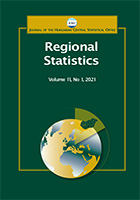Exploring non-linear relationships among
redundant variables through non-parametric
principal component analysis: An empirical analysis with land-use data
Exploring non-linear relationships among
redundant variables through non-parametric
principal component analysis: An empirical analysis with land-use data
Author(s): Gianluca Egidi, Magda Edwards, Sirio Cividino, Filippo Gambella, Luca SalvatiSubject(s): Social Sciences, Economy, Geography, Regional studies
Published by: Központi Statisztikai Hivatal
Keywords: multidimensional techniques; spearman non-parametric coefficients; Principal Component Analysis (PCA); large data sets ;indicators; regional science
Summary/Abstract: Principal Component Analysis (PCA) is a widely applied statistical technique aimed at summarising a multidimensional set of input (partly redundant) variables into a restricted number of independent components that are linear combinations of the inputs. PCA transforms the original data matrix by performing a spectral decomposition of the related variance/covariance (or correlation) matrix. When decomposing a correlation matrix, Pearson product-moment correlation coefficients are traditionally used in the correlation matrix. The statistical properties of Pearson correlation coefficients (being insensitive to non-linear, high-order correlations) represent an intrinsic limitation of PCA, restricting its applicability to linear relationships among inputs. However, working with variables displaying (more or less intense) deviations from linearity is common in both socioeconomic research and environmental studies. Following the theoretical assumptions of earlier studies, a generalisation of PCA aimed at exploring non-linear multivariate relationships among inputs is illustrated in the present article by using non-parametric Spearman and Kendall coefficients to replace linear Pearson coefficients in the correlation matrix. The percent share of 19 land-use classes in the total landscape in a given study area (the Athens metropolitan region, Greece), obtained from a high-resolution map at the local scale, were used as inputs. The results of the standard PCA (via decomposition of a Pearson linear correlation matrix) and a generalised approach (via decomposition of a nonparametric correlation matrix based on Spearman or Kendall rank coefficients) were compared using traditional diagnostics. The PCA performed by decomposing a Spearman correlation matrix exhibited the highest variance extracted by the principal components, giving refined loadings and scores that allow recognition of latent land use patterns. Contributing to a recent debate on the use of multidimensional techniques in regional studies, non-parametric approaches are promising tools for analysis of large datasets displaying complex, almost nonlinear relationships among inputs.
Journal: Regional Statistics
- Issue Year: 11/2021
- Issue No: 01
- Page Range: 25-41
- Page Count: 17
- Language: English

